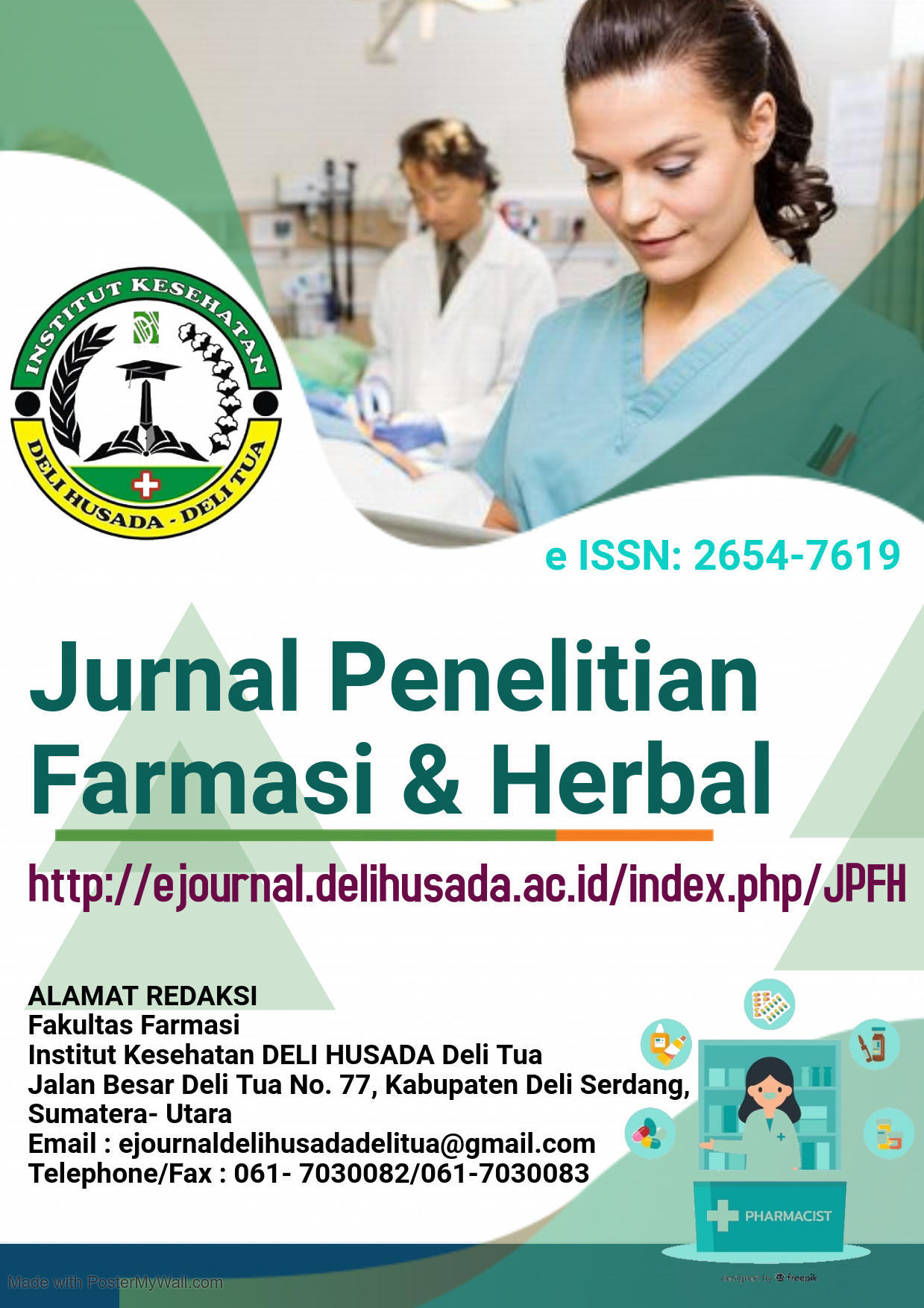REVIEW PENGARUH PENGGUNAAN SURFAKTAN PADA KARAKTERISTIK SEDIAAN ORODISPERSIBLE FILM (ODF) OBAT BERKELARUTAN RENDAH DALAM AIR: SIFAT DISINTEGRASI DAN DISOLUSI
Review Pengaruh Penggunaan Surfaktan dalam ODF
Abstract
Orodispersible film (ODF) is a drug delivery gaining widespread acceptance because it disintegrates quickly and can be self-administered. ODF has the advantage of increasing the active pharmaceutical ingredient (API) effectiveness by rapid dissolution in the oral cavity after direct contact with saliva. One of the components of ODF that influences the physical characteristics and dissolution of low-soluble drugs in water is surfactant. This material acts as a wetting or dispersing agent so the film can quickly disintegrate and release API. The method used is searching for international journal data using the Google Scholar. The surfactants reported to have been used in the ODF formulation are L-arginine, poloxamer 407, tween 80, and sodium dodecyl sulfate. In general, surfactant usage significantly affects the disintegration behavior of the film and API release. This behavior is caused by reducing the interfacial tension between phases by surfactants, which causes increased solid surface wetting and helps speed up the film disintegration and API dissolution from the ODF matrix. The conclusion is that surfactant usage with the appropriate type and concentration will help improve the ODF quality, especially in the disintegration properties of the dosage form and API dissolution.
Downloads
References
Chandramouli, M., Shivalingappa, R. P., Basavanna, V., Doddamani, S., Shanthakumar, D. C., Nagarajaiah, S. R., & Ningaiah, S. (2023). Oral Thin-films from Design to Delivery: A Pharmaceutical Viewpoint. Biointerface Research in Applied Chemistry, 13(2), 1–23. https://doi.org/10.33263/BRIAC132.177
El-Bary, A. A., Al Sharabi, I., & Haza’a, B. S. (2019). Effect of casting solvent, film-forming agent and solubilizer on orodispersible films of a polymorphic poorly soluble drug: an in vitro/in silico study. Drug Development and Industrial Pharmacy, 45(11), 1751–1769. https://doi.org/10.1080/03639045.2019.1656733
Fajria, T. R., & Nuwarda, R. F. (2018). Teknologi Sediaan Oral Lapis Tipis Terlarut Cepat (Fast Dissolving Film). Majalah Farmasetika, 3(3), 58. https://doi.org/10.24198/farmasetika.v3i3.23341
Khan, Q. ul ain, Siddique, M. I., Rasool, F., Naeem, M., Usman, M., & Zaman, M. (2020). Development and characterization of orodispersible film containing cefixime trihydrate. Drug Development and Industrial Pharmacy, 46(12), 2070–2080. https://doi.org/10.1080/03639045.2020.1843477
Manda, P., Popescu, C., Juluri, A., Janga, K., Kakulamarri, P. R., Narishetty, S., Narasimha Murthy, S., & Repka, M. A. (2018). Micronized Zaleplon Delivery via Orodispersible Film and Orodispersible Tablets. AAPS PharmSciTech, 19(3), 1358–1366. https://doi.org/10.1208/s12249-017-0924-9
Naji, G. H., & Abdul-jabar, K. H. (2021). Formulation and In Vitro Evaluation of Nimodipine as an Orodispersible Film. Indian Journal of Forensic Medicine & Toxicology, 15(2), 2406–2412. https://doi.org/10.37506/ijfmt.v15i2.14733
Nining, N., Elfiyani, R., & Wulandari, E. (2021). Comparison eugenol and oleic acid as a plasticizer on characteristic of dextromethorphan hydrobromide film by solvent casting method. Pharmaceutical Sciences Asia, 48(2), 139–146. https://doi.org/10.29090/psa.2021.02.20.023
Niraula, T. P., Bhattarai, A., & Chatterjee, S. K. (2014). Sodium dodecylsulphate : A very useful Surfactant for Scientific Investigations Biochemistry . This review article is related to present and future uses of sodium dodecyl sulphate in with change in temperature and addition of electrolyte . It causes skin a. The Journal of Knowledge and Innovation, 2(1), 111–113.
Noor, A. H., & Khalil, Y. I. (2015). Formulation and evaluation of felodipine orodispersible films. Pharmacie Globale, 6(4), 1.
Ouda, G. I., Dahmash, E. Z., Alyami, H., & Iyire, A. (2020). A Novel Technique to Improve Drug Loading Capacity of Fast/Extended Release Orally Dissolving Films with Potential for Paediatric and Geriatric Drug Delivery. AAPS PharmSciTech, 21(4), 1–14. https://doi.org/10.1208/s12249-020-01665-5
Qi, X., Zhang, J., Wang, W., & Cao, D. (2013). Solubility and stability of indomethacin in arginine-assisted solubilization system. Pharmaceutical Development and Technology, 18(4), 852–855. https://doi.org/10.3109/10837450.2011.595797
Rowe, R. C., Sheskey, P. J., & Quinn, M. E. (2009). Handbook of Pharmaceutical Excipients 6th Edition. In Pharmaceutical Press and the American Pharmacist Association, USA.
Sevinç Özakar, R., & Özakar, E. (2021). Current overview of oral thin films. Turkish Journal of Pharmaceutical Sciences, 18(1), 111–121. https://doi.org/10.4274/tjps.galenos.2020.76390
Sinko, P. J., & Singh, Y. (Eds.). (2011). Martin’s physical pharmacy and pharmaceutical sciences 6th edition (Sixth edit). Wolter Kluwer Health.
Steiner, D., Finke, J. H., & Kwade, A. (2019). Model-based description of disintegration time and dissolution rate of nanoparticle-loaded orodispersible films. European Journal of Pharmaceutical Sciences, 132(October 2018), 18–26. https://doi.org/10.1016/j.ejps.2019.02.029
Steiner, D., Tidau, M., & Finke, J. H. (2023). Embedding of Poorly Water-Soluble Drugs in Orodispersible Films—Comparison of Five Formulation Strategies. Pharmaceutics, 15(1). https://doi.org/10.3390/pharmaceutics15010017
Talekar, S. D., Haware, R. V., & Dave, R. H. (2019). Evaluation of self-nanoemulsifying drug delivery systems using multivariate methods to optimize permeability of captopril oral films. European Journal of Pharmaceutical Sciences, 130(December 2018), 215–224. https://doi.org/10.1016/j.ejps.2019.01.039
Taniguchi, C., Kawabata, Y., Wada, K., Yamada, S., & Onoue, S. (2014). Microenvironmental pH-modification to improve dissolution behavior and oral absorption for drugs with pH-dependent solubility. Expert Opinion on Drug Delivery, 11(4), 505–516. https://doi.org/10.1517/17425247.2014.881798
U. Singare, P., & D. Mhatre, J. (2012). Cationic Surfactants from Arginine: Synthesis and Physicochemical Properties. American Journal of Chemistry, 2(4), 186–190. https://doi.org/10.5923/j.chemistry.20120204.02







